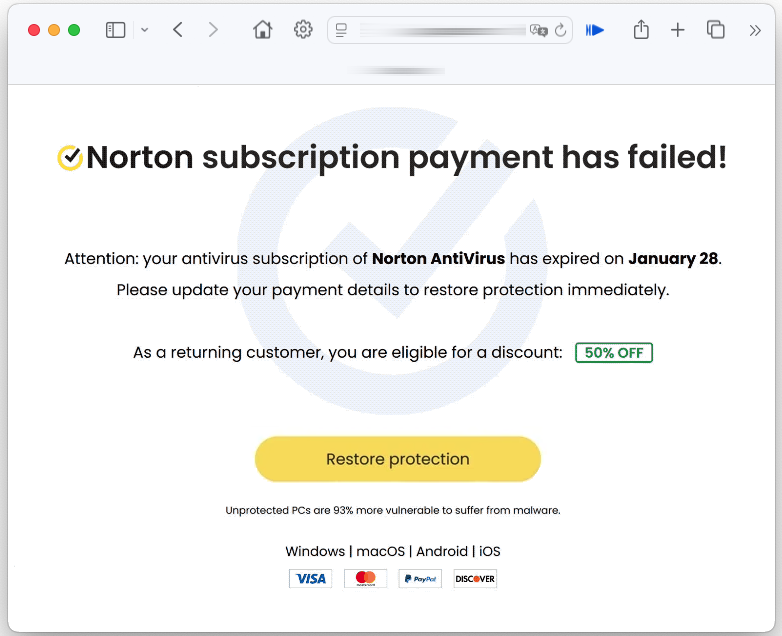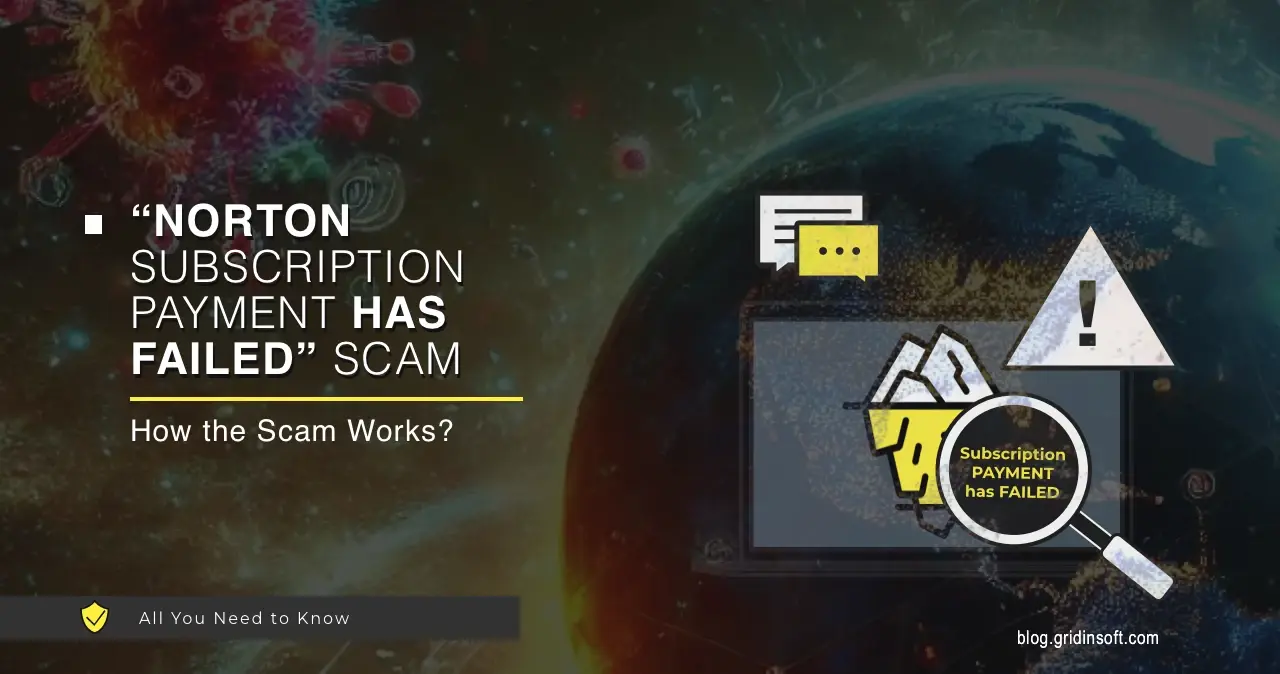Norton Subscription Payment Has Failed Scam is a fraudulent notification that appears on dubious websites designed to trick users into downloading unnecessary or malicious software. In this article, I explain why these fraudulent pages appear, and how you can stop it.
Norton Subscription Payment Has Failed Scam Overview
The “Norton Subscription Payment Has Failed” scam is a deceptive online scheme that falsely claims a user’s Norton AntiVirus subscription has expired and cannot be renewed. Even if the user has never used this anti-malware solution. Victims see alarming messages urging them to update their payment information to restore protection.

It has no relation to Norton, a real vendor of personal cybersecurity solutions. Con actors often use well known brand names because of its recognition and reputation, which can make the users believe the story about an expired subscription is real.
To make the scam more convincing, the message often includes an enticing 50% discount offer, or other “one-time deals”. The thing is – the timers that count the time before the offer expires reset with each page reboot, a definite sign of someone trying to scam the visitors.
As it typically happens, these fraudulent pages don’t lead to anything good. 90% of the time the user receives a pseudo antivirus instead of the genuine program, or even a potentially unwanted software. Rarely, such pages can redirect people to a real Norton purchase page, but I would not recommend following that offer. Purchases made by the affiliate link, which is used in that case, give a small pay to said affiliate, meaning that one can sponsor the scammers in such a way.
What is more worrying is that the page that may look like a genuine Norton website may in fact be a counterfeit, with a lot of tracking and keylogging scripts embedded into it. In that case, typing down any personal or financial information can lead to exceptionally worrying consequences.
How Does It Work?
There are two instances of the Norton Subscription Payment Has Failed scam to talk about. The first one is when the link leads to a fraudulent site that offers nothing but a fake program. The second, a much less likely one, leads to the original Norton website. Depending on the case, the goal and tactics are different. In any case the scam operates by displaying a pop-up or landing page claiming that a user’s Norton subscription renewal has failed.
This message includes a fabricated expiration date and a call to action, pushing the visitor to update their payment details. The urgency and discount offer are psychological tactics designed to lower skepticism and provoke impulsive actions.
In the first case, the link leads to an advertising/fraudulent site that offers to download the installer, while showing copious amounts of ads. The purpose of the scam is obvious: to make money on the ads and convince the user to download the advertised program’s installer. This app may range from just an unwanted program to an outright scareware, that will block normal system operations while demanding one to buy a full version.
In a more harmless version of the scam, most often these are all sorts of “optimizers” and system cleaners. They do not directly harm the system, but during their “scanning” they show the user a lot of problems. To fix them, the user is asked to buy a license. However, all these problems are not real, and the essence of the scam is to siphon off money.
More dangerous iterations may direct users to fake login pages designed to steal credentials or to malicious software downloads disguised as Norton updates. Some may even install browser-based threats that inject more misleading ads or attempt to harvest some data.
The second variant of this scam involves promoting a legitimate product in this way. Although no harm is caused by this campaign, it is a dirty method of advertising. The essence of this campaign is for the site to receive a commission for advertising/selling the product. Norton as a brand once again has no relation to that scam; they merely buy traffic from traffic arbitrage agents, who in turn may get their hands dirty.
How To Avoid Norton Subscription Payment Has Failed Scam?
Users often encounter scams like “Norton Subscription Payment Has Failed” due to intrusive advertising practices, malvertising, or adware infections. Some compromised websites redirect visitors to such fraudulent pages, while deceptive email campaigns may lure individuals into clicking malicious links. Even seemingly legitimate ads can lead to these scams if they originate from rogue advertising networks.
To protect yourself, it is crucial to understand the main rule of using the Internet: at this stage, the web page has no way to check the license status of the anti-malware product. You should be skeptical of alarming pop-ups demanding immediate payment updates, especially if you did not initiate a subscription renewal. Always verify subscription statuses directly on the official website rather than trusting in-browser notifications or third-party messages. Pay close attention to URLs, ensuring they match the genuine Norton domain before entering any personal information.
Avoid visiting piracy-related websites, as these are notorious for spreading scam pop-ups through aggressive advertising tactics. Do not enable browser notifications from suspicious pages, and be wary of unsolicited emails requesting you to verify payments or update sensitive details. If you suspect that your device is affected by adware, run a full system scan using a reputable anti-malware tool. This will help identify and remove any unwanted applications that might be serving these deceptive messages.




